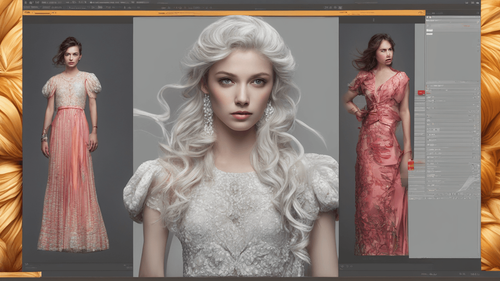
Introduction: Unlocking the Magic of Vectorization
In the realm of digital artistry and graphic design, the power of vectors is undeniable. They provide the flexibility to scale, transform, and manipulate images without compromising on quality. Creating vectors from images is an essential skill for designers, and Adobe Illustrator stands as the paragon for this purpose. In this comprehensive guide, we delve into the process of using Adobe Illustrator to transform raster images into versatile vector masterpieces, unraveling the techniques, tips, and insights that will elevate your artistic journey.
Understanding Vectors and Rasters
Vectors: The Building Blocks of Scalability
Vectors, as opposed to raster images, are comprised of paths defined by mathematical equations. This grants them the remarkable ability to scale infinitely without any loss of quality. This scalability makes vectors ideal for logos, illustrations, and designs that need to be resized for various applications.
Raster Images: The Grid of Pixels
Raster images, also known as bitmaps, are made up of a grid of pixels. Each pixel carries color information, and when you zoom in on a raster image, you'll eventually perceive the individual pixels. While ideal for photographs, raster images can appear pixelated if resized beyond their original dimensions.
The Power of Adobe Illustrator
Adobe Illustrator: The Ultimate Vectorization Tool
Adobe Illustrator stands as the vanguard in vector image creation. Its versatile tools and features empower designers to trace, recreate, and enhance raster images with precision. From the Image Trace function to the Pen Tool, Illustrator provides a comprehensive arsenal for vectorizing various types of artwork.
Importing Your Raster Image
- Launch Adobe Illustrator.
- Go to 'File' > 'Open' and select your raster image.
- Choose the 'Image Trace' option from the 'Window' menu.
Choosing the Right Settings
Illustrator offers pre-defined settings for tracing images, such as 'Black and White Logo' or 'Colorful Artwork.' Experiment with these settings to achieve the desired vectorization effect. You can also customize settings based on your image's complexity.
Adjusting Paths and Anchor Points
Vectorization might yield paths with excessive anchor points. Use the 'Path' and 'Simplify' options to refine your vectors. Fewer anchor points lead to smoother curves and reduced file sizes.
Mastering the Pen Tool for Precision
The Pen Tool: Your Artistic Compass
The Pen Tool in Adobe Illustrator enables you to create precise anchor points and paths. It's indispensable for recreating intricate shapes and details in your vectorized image.
Creating Paths with the Pen Tool
- Select the Pen Tool from the toolbar.
- Click to create anchor points, and click and drag to create curved segments.
- Close paths by clicking on the initial anchor point.
Fine-tuning Curves with Bezier Handles
Bezier handles control the direction and curvature of paths. To achieve seamless curves, adjust these handles using the Direct Selection Tool. Smooth out anchor points by pulling the handles in the direction of the curve.
Enhancing Your Vector Artwork
Adding Color and Filling Shapes
Once your image is vectorized, you can start adding color. Use the 'Fill' and 'Stroke' options to customize the appearance of your vector elements. Experiment with gradients, patterns, and transparencies to infuse life into your artwork.
Organizing with Layers
Effective organization is key to managing complex vector artwork. Utilize layers to separate different elements of your design. This allows you to make edits without affecting the entire composition.
Utilizing the Live Paint Bucket
The Live Paint Bucket simplifies the process of applying color to intricate vector shapes. Select the tool, click on enclosed areas, and watch as Illustrator intelligently fills the shape with your chosen color.
FAQs
Can I Vectorize Photographs in Illustrator?
Yes, Illustrator's Image Trace function can transform photographs into vector artwork. Keep in mind that highly detailed images may require manual adjustments post-tracing.
Is Adobe Illustrator Suitable for Beginners?
While Illustrator offers robust features, it can be complex for beginners. However, with practice and tutorials, even novices can harness its power.
Can I Edit Vector Paths After Creation?
Absolutely. Illustrator allows you to edit paths and anchor points even after they're created. This flexibility ensures that your artwork remains adaptable.
What File Formats Can I Export My Vector Artwork In?
Illustrator lets you export your vector creations in various formats, including AI, SVG, PDF, and EPS. Choose the format that best suits your intended use.
Do Vector Files Have a Smaller File Size Than Raster Images?
Yes, one of the advantages of vector files is their smaller file size compared to raster images. This makes them ideal for web graphics and applications with limited storage.
Can I Convert Existing Vector Shapes into Paths?
Certainly. Illustrator allows you to convert shapes like rectangles or circles into paths, granting you more control over their manipulation.
Conclusion: Transforming Vision into Vector
As the digital landscape continues to evolve, the demand for versatile and scalable graphics grows. The ability to create vectors from images is a cornerstone skill for any designer, and Adobe Illustrator excels in equipping artists with the means to achieve this feat. From understanding the basics of vectors and rasters to mastering the Pen Tool and enhancing your artwork, this guide has illuminated the path to vectorization mastery. Unlock your creative potential, and let Adobe Illustrator be your guiding light in transforming visions into timeless vector artworks.